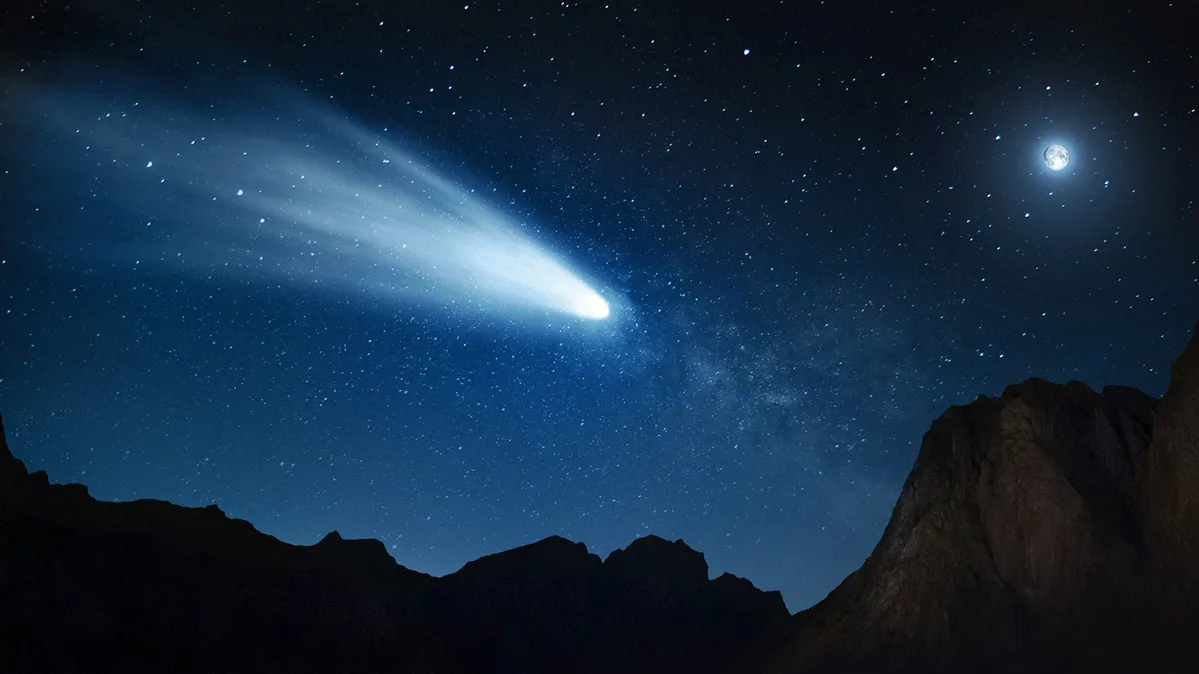Joe Gutierrez | CSUSB Office of Strategic Communication | (951) 236-4522 | joeg@csusb.edu

The comet NEOWISE may no longer be visible in the night sky to the unaided eye, but Cal State San Bernardino physics and astronomy professor Laura Woodney continues to unravel the secret lives of comets.
Born in the far-flung realms near Jupiter, Saturn, and beyond, comets likely spend most of their subzero lives beyond the orbit of Neptune, where they are known as Trans Neptunian Objects (TNOs). Others lie further afield in the most distant region of the solar system known as the Oort Cloud. But exactly how the cosmic snowballs of frozen gases, rock, and dust arrive from these frigid outskirts and swing closer to Earth’s neighborhood has puzzled scientists.
Woodney, along with others, is advancing research that could reveal information about “Centaurs” – little-known icy bodies with the characteristics of both comets and TNOs – and lead to new discoveries about our solar system.
“The more we understand about comets, the more we understand about the formation of the planets, how comets may have contributed to the composition of early planetary atmospheres, and ultimately, the conditions under which life arose on Earth,” said Woodney, a professor in the College of Natural Sciences Department of Physics.
Woodney is a co-author of a study led by University of Central Florida planetary scientist Gal Sarid (also with Science Systems and Applications, Inc., and the SETI Institute) that describes the discovery of an orbital “gateway” through which many comets pass before they approach our sun. As a comet’s orbit brings it closer to the sun, it begins to heat up and release gas that, together with dust, creates the signature kilometers-long tail and glowing, surrounding halo, or “coma.”
It has long been believed that the comets found in short-period orbits in the inner solar system are the end result of a journey that begins beyond Neptune. In those distant reaches they are known as TNOs, dormant and orbiting as time capsules of sorts. They are virtually unaltered since they were deposited there during the solar system’s formation over 4 billion years ago.
Gravitational interactions send some TNOs into the transitional Centaur region between Jupiter and Neptune where they first begin to display occasional comet-like activity. From here the giant planets effectively play pinball with the tiny Centaurs, either ejecting them from the solar system or sending them in to an end-life as an active comet with frequent passages into the inner solar system.
Woodney and fellow researchers had been studying one particular Centaur, designated as 29P/Schwassmann-Wachmann 1 (SW1), which is the target of their NASA Discovery mission concept known as Chimera. SW1, which occupies a nearly circular orbit just beyond Jupiter, has mystified scientists because of frequent explosive outbursts similar to those that typically occur when an icy body is closer to the sun.
Centaurs can be challenging to study because their relatively small sizes (typically tens of kilometers) and large distances from the Sun and Earth make them so faint that even large telescopes struggle to detect the signatures of their composition. However, the evolutionary link they provide between the active short-period comets and the pristine TNOs make Centaurs worth the effort to study and attractive targets for robotic spacecraft missions.
The team’s simulations of the orbital characteristics of Centaurs revealed a way to predict which of these objects are more likely to become comets. Analysis of the orbits of thousands of test objects revealed the surprising result that Centaurs passing through orbits similar to SW1s are the source of more than two-thirds of all short-period comets, making this orbit the primary “gateway” through which this type of comet is produced – a “cradle of comets.” This makes SW1, a nearly 60-kilometer-diameter object, poised to become the largest short-period comet in recorded history.
“As the most active small body in the outer solar system, SW1 was already a prime candidate for study by robotic spacecraft,” said Woodney. “This discovery enhances that by telling us that if NASA chooses our mission to fly, we have the chance to make in situ (in position) measurements during the birth of a comet.”
The research was published in a recent issue of The Astrophysical Journal Letters. In addition to lead scientist Sarid and Woodney, the study’s co-authors are Walter Harris of the Lunar and Planetary Laboratory at the University of Arizona, Jordan Steckloff of the Planetary Science Institute and University of Texas at Austin, Kathryn Volk of the Lunar and Planetary Laboratory, and Maria Womack of the Florida Space Institute.
“Laura Woodney has spent her scientific career advancing our knowledge of our solar system,” said Sastry G. Pantula, dean of the College of Natural Sciences. “Her high-profile role in space research readily inspires students who are eager to learn more about the secrets of the universe and work hard to lead their own research efforts as future astronomers and physicists.”
For more information visit the CSUSB Department of Physics website.